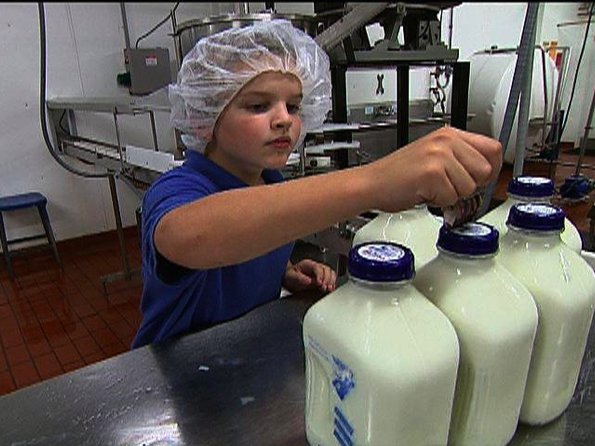Have a cow, man. Why not? After all, it's Dairy Month here at OnMilwaukee.com. Join us all month long as we explore all things that make you go "Moo" and celebrate America's Dairyland during the Dairy Days of Summer! Brought to you by OnMilwaukee.com and the Wisconsin Milk Marketing Board.
It's no secret that limburger cheese stinks. Its legendary odor has been compared to body odor, stinky feet and a variety of dead or dying creatures. Sadly, many people won't even give it a taste due to its distinctively pungent aroma. But, before you dismiss this Wisconsin classic, read on. It turns out there's a lot more to limburger than meets the nose.
Although named for the city of Limburg, Belgium where it was first sold, limburger is renowned as a German cheese, since Germany is where it gained its popularity. And it was the German and Swiss immigrants who settled here in Wisconsin who helped to keep the torch burning. In 1867, Rudolph Benkerts, a Wisconsin cheesemaker in Green County, began making limburger cheese in his home cellar. By 1880, the cheese was being made at 25 cheese factories in the county, and by 1930, there were more than 100 companies producing it.
Today, however, there is only one remaining creamery manufacturing limburger – the Chalet Cheese Cooperative in Monroe, Wis. The Chalet produces about 500,000 pounds of limburger annually, and the cheese is shipped throughout the United States according to demand.
If you visit Chalet and chat with Master Cheesemaker Myron Olson, you'll learn a great deal about this legendary cheese. One of the first things you'll learn is that limburger doesn't start out smelling like much at all; its pungency actually comes with age. When the cheese is very young, up to one month old, it is firm, crumbly and salty, much like feta. At six weeks, it softens around the edges but still maintains a firm center that's salty and chalky. At two months, the firmness dissipates and the body is smooth and creamy while the flavor is sweet and earthy. At three months or more, it is soft and spreadable with a pungent odor that emanates from its soft reddish-brown exterior rind. However, its creamy center possesses a tame, tangy flavor and luxurious mouth feel that is surprisingly similar to Brie.
Most native Wisconsinites seem to have at least one story related to the consumption of limburger. And Olson has heard them over and over.
"The best and most repeated story that I have heard concerns the home curing process of limburger to get it to the proper age to eat," he recollects. "Usually it is about either Grandma or Grandpa, or both, taking the limburger home, taking the wrapper off and placing the limburger into an empty peanut butter jar. The jar would be placed on the kitchen counter, on the back porch, above the old stove or even on the kitchen table. It would be left at room temperature for days until it was soft enough to spread on bread. When this jar was opened and the aroma of aged limburger filled the house, everyone, especially the grandkids, would make a mad dash to the outdoors to escape the odor. To Grandma and Grandpa this was a real treat, but I think this is why we lost a generation of limburger eaters."
Margaret Mittelstadt, director of community relations for Outpost Natural Foods Cooperative, didn't let the smell of limburger keep her from enjoying it. She grew up in Cedarburg, where she remembers not only the local supermarket butcher case filled with sausages and braunschweiger, but also the deliciously stinky cheese.
"Paulus' Supermarket on Main Street was very German," she says, "which explains having items in stock like the limburger. It was a regular purchase for us. Dad loved his cheese 'sammiches' with onions on rye bread with a cold Pabst. All of us kids would giggle when my mom hauled it out of the fridge, all wrapped up in paper. Limburger is the cheese of my people. Wonderful memories."
Bill DeLind, owner of DeLind Gallery of Fine Art, also has fond memories of limburger, recalling that he and his brothers often played pranks with the cheese.
"One involved hiding an open package of limburger in my brother's refrigerator, when it was totally loaded for Christmas cooking," he recalls. "It took him several days to discover; it still brings tears to my eyes to relive that delicious prank."
And DeLind isn't alone. For many, just the smell of storing the cheese is enough to keep them from making it a regular purchase.
Karen Gill, Milwaukee chef, said that she first tried the cheese about three years ago and loved it, but she was definitely put off by its odor.
"It reminded me of the fancy, stinky cheese in France," she said. "I bought some to eat at home and was devastated when I could never mask the stink in my kitchen; [I] even tried freezing it. I decided then I will just enjoy it at Wisconsin Cheese Mart."
But, one needs only to chat with a cheesemaker or two to find out that there are secrets to acclimating to the smell of the cheese and enjoying it to its fullest.
"When I hired a general manager from the Netherlands, I first tried the cheese," says Bob Wills, master cheesemaker at Cedar Grove Cheese and founder of Milwaukee's Clock Shadow Creamery. "He said the trick was to put the open limburger on one side of the room and the bar on the other. Then, gradually – maybe the period that a couple drinks would take – work your way across the room. With one's nose adjusted, the cheese is delicious. Having become a fan, I found that the Green County folk know just the right balance between limburger, raw onion, rye, braunschweiger and beer. It is really a separate branch of science."
Myron Olson also admits that limburger is an acquired taste. Although he grew up on a dairy farm and drank raw milk, he didn't like cheese. Intimidated by the smell of the whey-corn mixture his father fed to the family pigs and grossed out by the stories he heard about rennet being manufactured from calf stomachs, Olson preferred to avoid cheese altogether.
So, he didn't begin trying to enjoy the product his family produced until he had been working at the Chalet for over a year. His first cheese experience was nibbling on the warm salty fresh cheese curds that the creamery produced. Eventually, he began branching out and trying other styles of cheese.
"I now like every style that is made, including limburger," Myron reports. "So it is never too late to become a cheese lover."
Inspired to try out a bit of limburger for yourself?
If so, here's a few hints for when you get your cheese home: To help remove the smell, rinse the rind or cut it off. Store the cheese in a glass jar to prevent it from smelling up your entire refrigerator. And don't feel as if you need to eat it "straight up"; try the cheese topped with strawberry jam or honey to complement its earthy sweetness.
You may also be interested to know that, based on consumer demand, the folks at Clock Shadow Creamery are contemplating production of a variation of limburger starting this fall.
As a passionate champion of the local dining scene, Lori has reimagined the restaurant critic's role into that of a trusted dining concierge, guiding food lovers to delightful culinary discoveries and memorable experiences.
Lori is an avid cook whose accrual of condiments and spices is rivaled only by her cookbook collection. Her passion for the culinary industry was birthed while balancing A&W root beer mugs as a teenage carhop, fed by insatiable curiosity and fueled by the people whose stories entwine with every dish. Lori is the author of two books: the "Wisconsin Field to Fork" cookbook and "Milwaukee Food". Her work has garnered journalism awards from entities including the Milwaukee Press Club. In 2024, Lori was honored with a "Top 20 Women in Hospitality to Watch" award by the Wisconsin Restaurant Association.
When she’s not eating, photographing food, writing or planning for TV and radio spots, you’ll find Lori seeking out adventures with her husband Paul, traveling, cooking, reading, learning, snuggling with her cats and looking for ways to make a difference.







